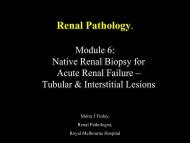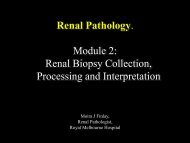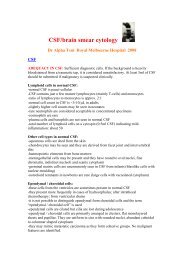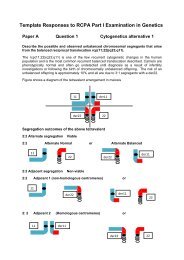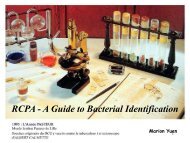Vomiting & Diarrhoea in a nursing home - Rcpa.tv
Vomiting & Diarrhoea in a nursing home - Rcpa.tv
Vomiting & Diarrhoea in a nursing home - Rcpa.tv
You also want an ePaper? Increase the reach of your titles
YUMPU automatically turns print PDFs into web optimized ePapers that Google loves.
Antibiotic resistance: recent abstract<br />
Low-level fluoroqu<strong>in</strong>olone resistance among Campylobacter jejuni isolates <strong>in</strong><br />
Australia.<br />
Cl<strong>in</strong> Infect Dis. 2006 May 15;42(10):1368-74. Epub 2006 Apr 13. Unicomb LE, et al; Australian<br />
Campylobacter Subtyp<strong>in</strong>g Study Group.<br />
BACKGROUND: Ciprofloxac<strong>in</strong>-resistant Campylobacter jejuni isolates obta<strong>in</strong>ed from <strong>in</strong>fected patients <strong>in</strong><br />
Australia have not been detected <strong>in</strong> studies of isolates from specific geographic areas. The Australian<br />
government has prohibited the use of fluoroqu<strong>in</strong>olone <strong>in</strong> food-produc<strong>in</strong>g animals. To assess the impact of<br />
this policy, we have exam<strong>in</strong>ed the antimicrobial susceptibility of isolates from 5 Australian states.<br />
METHODS: We conducted a period-prevalence survey of the susceptibility of C. jejuni isolates to 10<br />
antimicrobial agents. C. jejuni isolates obta<strong>in</strong>ed from 585 patients from 5 Australian states (Queensland,<br />
South Australia, Tasmania, Victoria, and Western Australia) were identified by means of notifiable disease<br />
databases and were systematically selected from September 2001 to August 2002. RESULTS: Among<br />
locally acquired <strong>in</strong>fections, only 2% of isolates (range, 0%-8% <strong>in</strong> different states) were resistant to<br />
ciprofloxac<strong>in</strong>. The locally acquired isolates also exhibited resistance to sulfisoxazole (55%), ampicill<strong>in</strong><br />
(46%), roxithromyc<strong>in</strong> (38%), tetracycl<strong>in</strong>e (7%), nalidixic acid (6%), chloramphenicol (3%), erythromyc<strong>in</strong><br />
(3%), gentamic<strong>in</strong> (2%), and kanamyc<strong>in</strong> (0.2%). Treatment with antimicrobial agents <strong>in</strong> the 4 weeks before<br />
onset was not associated with ciprofloxac<strong>in</strong> resistance. CONCLUSIONS: The very low level of ciprofloxac<strong>in</strong><br />
resistance <strong>in</strong> C. jejuni isolates likely reflects the success of Australia's policy of restrict<strong>in</strong>g use of<br />
fluoroqu<strong>in</strong>olones <strong>in</strong> food-produc<strong>in</strong>g animals.<br />
Return to scenarios





